"Nivel Meat Grinder"
The situation before the battle. Nivel's Plan
At an allied conference in Chantilly in November 1916, it was decided to intensify actions on all fronts, with the most forces at the very beginning of 1917, in order to maintain the strategic initiative. Entente powers were going to use their superiority in manpower and equipment and decide the course of the war during the 1917 campaign of the year. The French commander-in-chief, General Joffre, divided the 1917 campaign into two periods: 1) winter - operations of local importance to prevent the enemy from launching a decisive offensive and not allowing him to save reserves before summer time; 2) summer - a broad offensive on all major fronts.
The initial action plan in 1917 in the French theater was drawn up by General Joffrom and consisted in repeating the strike on both sides of the Somme simultaneously with a decisive attack on the Russian, Italian and Balkan fronts. According to the general plan of Joffre, the British began an offensive on the French front in the area of Arras, a few days later the northern troupe of the French armies between Somme and Oise was to support them. After 2, the weeks after that, the 5 army from the reserve group between Soissons and Reims was planned to be thrown into battle: to develop the success of the main attack inflicted by a group of British armies and the northern group of French armies, or for an independent breakthrough if the attack of the main forces drowns. The French High Command planned to inflict a decisive defeat on the German army: to break through the front and use it to completely defeat the enemy. At the same time, the Italian troops were to attack the Isonzo, and the Russian-Romanian and Salonik armies - to attack the Balkans in order to disable Bulgaria.
However, in France in connection with the Romanian catastrophe there was a change in the office of Briand, replaced by his ministry of Ribot. Almost simultaneously, after numerous political intrigues, the French commander-in-chief, General Joffre, was replaced, whose place was taken by General Robert Nivelles. Nivelle served in Indochina, Algeria and China and received the rank of brigadier general during the First World War. During the Verdun battle, 1916 was the main assistant to Petain and showed his commanding talent, commanding French troops during the capture of Fort Duamon. Soon Nivelle became commander of the Verdun sector.
On January 25, the new French commander-in-chief Nivelle presented his plan of operations on the Western Front for the 1917 year. The general offensive was scheduled for early April and was supposed to start with two powerful blows in the area of the town of Cambrai (60 kilometers northeast of Amiens) and a little east of the river Ein. In order to speed up the "frustration" of the enemy, according to Nivel, then the troops were to go on the offensive in other sectors of the front. The operation was divided into three stages: 1) crush as many enemy forces as possible, shackling the rest of the enemy forces in other sectors of the front; 2) push forward the maneuverable mass with the aim of delaying and smashing the German reserves; 3) to develop and use the progress achieved to inflict a decisive defeat of the German army.
The British offensive in the direction of Cambrai and the operation of the northern group of French troops against the greatest number of enemy forces were to distract the enemy. Then a few days later the main mass of the French troops (reserve army group) broke through the enemy defense on the r. Ena and the operation to defeat the German troops connected by the first group. The troops in the remaining sectors of the front went over to a general offensive, completing the frustration and defeat of the German army. Thus, the essence of the plan was to seize the German protrusion from Noyon, which led to the destruction of a significant mass of German troops and the appearance of a large gap in the enemy defensive line. This could lead to the collapse of the entire German defense on the Western Front and the decisive defeat of the German army.
British Prime Minister Lloyd George supported Nivelle, instructing him to command British troops in a joint operation. The French general claimed that a massive strike on the German line of defense would lead to the victory of France within 48 hours. At the same time, Nivelle spoke about his plan to anyone who was interested in him, including journalists, as a result of which the German command found out about the plan and the element of surprise was lost.
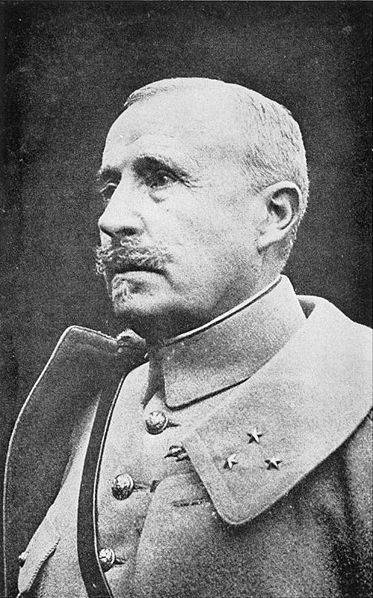
French commander Robert Nivelle
Change of operation plan
While the Allies were preparing for a decisive offensive, the German command confused all the cards of the French, unexpectedly beginning in February a prepared operation to withdraw troops to a well-prepared position on the entire front from Arras to Vaya on the r. Ena This withdrawal was begun after the Supreme German command decided to move to a strategic defense and to withdraw the troops occupying the protrusion from Noyon from a dangerous position. The troops took to the so-called. "The Hindenburg Line", which was built for almost a year. The line had several rows of trenches, wire fences, minefields, concrete bunkers, machine gun nests, bunkers and bunkers for infantry, connected by underground tunnels. It was believed that these fortifications should withstand even the blows of the enemy's heavy artillery. By reducing the front, the Germans were able to consolidate the defensive orders and to allocate additional reserves (up to 13 divisions). The French missed the withdrawal of the German army, and the pursuit of the enemy, begun by the 3, did nothing.
The Deputy Chief of the German General Staff, General Erich von Ludendorff described the course of the operation: “In close connection with the beginning of the submarine war, we decided to withdraw our front from the arc bent towards France to Siegfried's position (one of the sections of the Hindenburg Line - A. C .), which by the beginning of March was supposed to be defensive, and produce systematic damage in the strip, a width of 15 kilometers, in front of the new position. " By withdrawing the troops, the Germans took out everything they could - food, metals, wood, etc., and destroyed what they left, following the "scorched earth" tactics - routes, buildings, wells. “Deciding to take the front back was extremely difficult,” wrote Ludendorff, “This was a recognition of our weakness, which was supposed to act encouragingly on the enemy and overwhelmingly on us. But since from a military point of view, a retreat was necessary, there was no choice. ”
The situation has changed dramatically. By mid-March, German troops made a successful retreat to a new well-prepared defensive line. There was a revolution in Russia. The events in Russia, on the one hand, made the allies happy - the Provisional Government was easier to manipulate than the tsarist government, on the other hand, they threatened to weaken the onslaught of the Russian army (Russian commander-in-chief Alekseev refused to launch a decisive offensive in early spring). A performance on the side of the Entente did not promise quick help. The Americans did not hurry with the transfer of the army to Europe. All this made the French government think about whether it should be postponed. After a series of discussions, the offensive in the French and Italian fronts was decided to start in April 1917, while the Germans had not yet withdrawn the troops from the Russian front. In this case, the government instructed to stop the offensive operation, if the front breakthrough is not achieved within 48 hours.
The withdrawal of the German troops led to a regrouping of the Allied armies and a change in the original plan. The main attack was now inflicted by a group of reserve armies, which was to break through the German front between Reims and the Enskim Canal: the 5 and 6 armies were intended to break through the front, and the 10 and 1 armies (the latter was thrown from the northern army group ) - for the development of the offensive. This main strike was supported by the right 4-I army, attacking between Reims and r. Syuip, and to the left - the northern army group, attacking south of Saint-Quentin. The 3-I and 1-I British armies delivered a secondary blow.
Thus, instead of capturing the pawns of the Noyon protrusion, which was the essence of the first plan, the stakes were made on breaking through the center of the German location between the sea and Verdun and with a break on a broad front in the form of a wedge, the acute angle of which was the shock armies of the reserve group. This breakthrough was to help the secondary attack of British troops.
The forces of the parties
Allied forces ranged from Newport to the Swiss border. From Newport to Ypres stood the French Corps (on the coast) and the Belgian army. From Ypres to the Rua - Amien road, five British armies defended. From this road to Soissons is the northern group of the French armies, consisting of the 3 and 1. From Soissons to Reims - a reserve group of French armies, having 6 and 5 on the front and 10 in reserve. In Champagne and in Verdun, from Reims to S.-Miel - the army group of the center, from the 4 and 2 armies. From Saint-Mijel to the Swiss border - 8-I and 1-I armies.
The German army stationed from the sea to Soissons a group of the Cavrince of the Bavarian of the three armies: 4-th - in Belgium, 6-th - from the Belgian border to Arras and 2-th - from Arras to Soissons. From Soissons (the Crown Prince German's group was located to Verdun: having 7-th army from Soissons to Reims, 3-th - from Reims to headwaters of the En river and 5-th - to Verdun. This was also spread from the north and 1-th army received the area between the 7 and 3 armies. From Verdun to the Swiss border, a group of the Duke of Württemberg from 3 army units with a protrusion at Saint-Mijel and further along the state border held up defense. It is worth noting that the Germans easily transferred their troops from Russian to the French front and back using developed network of railways in the German Empire.
In April 1917, the allies on the Western Front had large forces and means. Entente troops were French, British, Belgian and Portuguese troops, as well as the Russian Expeditionary Force. The total number of allied forces was about 4,5 million people (about 190 divisions), more than 17,3 thousand guns, the German army had 2,7 million people (154 divisions), 11 thousand guns. In total, it was planned to attract more than 100 infantry divisions of the Allies and over 11 thousand guns of all types and calibers, about 200 tanks and 1 thousand aircraft. The German command in the direction of the main strike had 27 infantry divisions, 2431 guns and 640 aircraft.
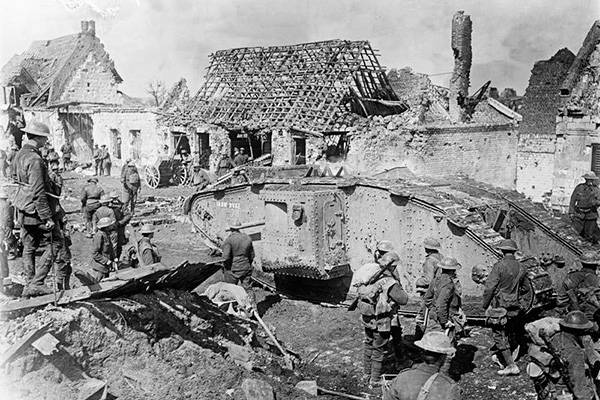
Battle of Skarpa 10 April 1917
Bits
On April 9 in the north of France, the Allies launched the first major offensive in 1917. Only English units participated in it, which attacked the positions of the Germans in the area of the city of Arras. In addition to the British proper, parts of the dominions - Canadian, New Zealand and Australian - took an active part in the battle.
The British had a lot of preparatory work. Thus, British engineers dug to the forefront of tunnels with a total length of more than 20 kilometers, in which railways were laid to deliver ammunition and laying mines. Only in these tunnels could 24 accommodate thousands of people. From a tactical point of view, the British took into account the experience of the Battle of the Somme, choosing to attack one small section of the front, which was supposed to reach the maximum density of artillery fire. Artillery preparation began on April 7 and lasted two days, during which more than 2,5 million shells were spent. However, the British did not achieve any special effect, except for the fact that the supply of food to enemy positions was disrupted and the German soldiers in some areas were left without food for more than three days. Also, the British were not lucky in the air, because under Arras it was not possible to concentrate enough experienced pilots to achieve air supremacy. The Germans, because of the inaction of the Russian army, which quickly decayed, were able to gather on the Western front the most experienced aces.
April 10-12 continued fierce fighting near the city of Arras. Despite the most powerful artillery preparation, the whole offensive of the British army failed. Only on the northern outskirts of Arras, in the Vimy Upland region, Canadian soldiers were able to break through the enemy defenses in a small area. With the support of the tanks, they were able to advance several kilometers into the depths of the enemy’s defensive orders. At the same time, the main fortifications of the Hindenburg Line, which was considered impregnable in this area, were almost completely destroyed, and the Germans did not have time to pull up reserves on the muddy and broken roads. But the British tanks, in turn, were bogged down in mud, and they failed to timely transfer artillery after the advancing infantry. The Allies could not establish interaction with the artillery and tanks. As a result, the Germans by 13 April managed to close the gap, moving the surviving units to the second line of defense.
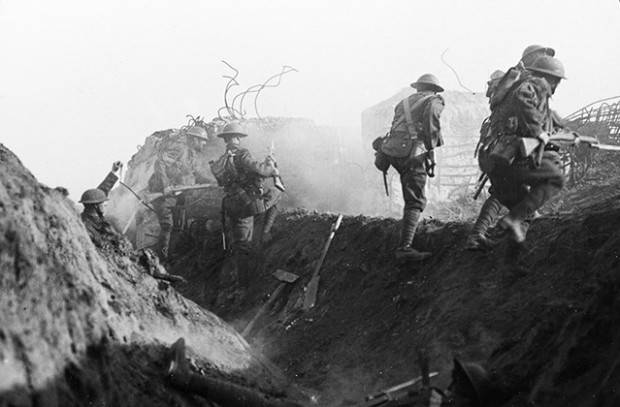
British infantry attack
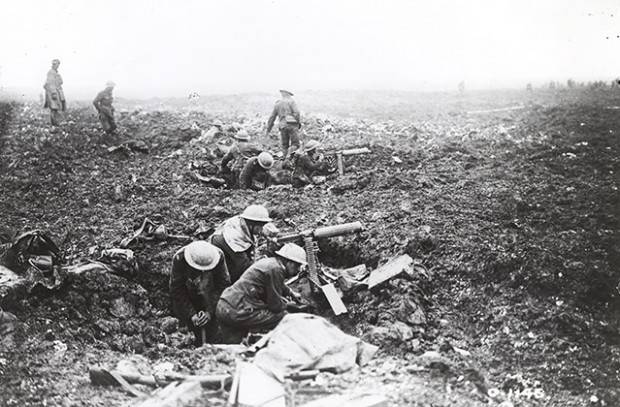
Canadian machine-gunners in Vimy, April 1917
On April 16 in Champagne, in the region of Soissons, the French units (5 and 6 armies) also launched an offensive, which were originally supposed to attack simultaneously with the British. The advance of the main forces of the French armies in the direction of the main attack was preceded by artillery preparation conducted from 7 to 12 in April. The offensive due to poor artillery preparation was postponed until April 16, but the new artillery preparation also did not produce the expected results.
The Germans were ready to attack the enemy. Two weeks before the start of the operation, the Germans captured the French non-commissioned officer, who had with him a copy of the basic plan of the operation. It also mentioned that the British strike near Arras would be distracting. As a result, the German command withdrew the main forces from the first line so that they would not come under artillery attack, leaving only machine-gun crews in concrete caps. The French immediately fell under terrible machine-gun and artillery fire and suffered huge losses, only in places having managed to capture the enemy's advanced trenches. The first Schneider tanks, which showed themselves worse than the English, did not help the French either. Of the 128 vehicles of the first detachment thrown at the enemy, the Germans killed 39. The second detachment of the Schneiders, which was attacked by the German aviation, was destroyed almost entirely - 118 of 128 vehicles. Some of the cars fell into pre-prepared ditches. The weak points of these tanks were the extremely unreliable tractor chassis and low speed, which made them easy prey for German artillery. In addition, during an attack near Soissons, in order to increase the power reserve, additional fuel tanks were attached to the tanks outside, which caused the Schneiders to burn very well.
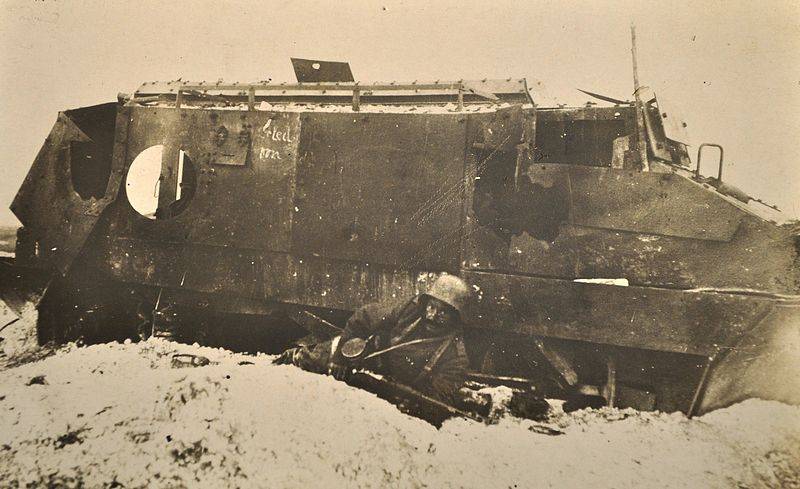
Padded French tank "Schneider"
17 April attack was continued. The 4-I French army, supported by 10, continued the general offensive. The fiercest battles of these days broke out in an area known as the "Champagne Hills", east of the city of Reims. On the first day, the French advanced only 2,5 kilometers deep into enemy territory, by 23 April - to 5-6 kilometers, and then only in some areas. The attackers captured more than 6 thousands of Germans, while the losses of the French army in just 5 days of combat amounted to more than 21 thousands killed and wounded. The offensive did not bring decisive success, the German troops in an organized manner retreated to the next line of defense.
Thus, the advance of the French army failed. A military historian, General Andrei Zayonchkovsky, wrote about Nivel’s operation: “By the number of troops, artillery, shells, aircraft and tanks assembled here, the French attack between Soissons and Reims was the most ambitious enterprise of the entire war. Naturally, the French could expect complete success from a breakthrough and be confident in developing it into a big strategic victory. But the hopes of the French were not justified. The lengthy preparations and political discussions caused by this attack, together with the 10-day artillery preparation, took away all the benefits of surprise, and the bad weather deprived the French troops of the participation of strong aviation. ”
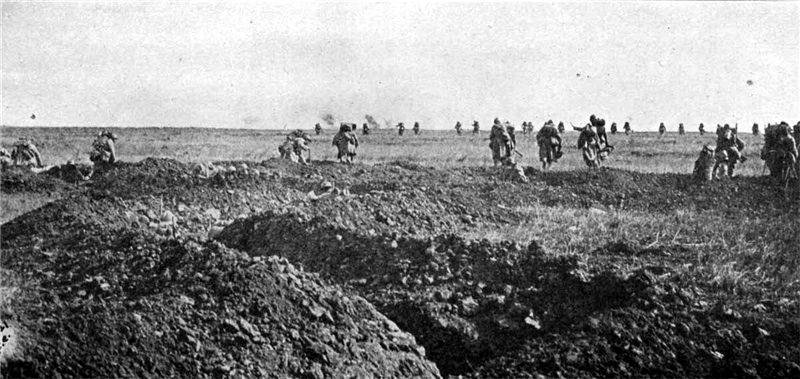
Attack of the French infantry
In the meantime, the bloody battle was still going on. British commander Lord Haig 22 also announced on April that he would “continue the British offensive to support our allies,” although the French had stopped their attacks for some time because of the huge losses. As the historian of the First World War, Bezil Liddell Harth, noted, in fact, at that time already there was “nothing and no one to support”. 23 April, British troops attacked the Germans in the valley of the Scarpa River. At the first stage, they managed to seize the advanced trenches of the enemy, but then the Germans pulled up reserves and counterattacked. Desperate efforts of the Canadian Royal Newfoundled Regiment fighters managed to defend the captured village of Monche-le-Pro, which was the last success of the allies. After that, given the heavy losses, General Haig halted the fruitless offensive.
28 April, Canadians were able to make some progress again and captured the village of Arles-en-Goël, located near the village of Vimy, occupied two weeks earlier. The Russian military historian Zayonchkovsky described the general results of the British offensive in such a way: “All these attacks in some places improved only the tactical position of the Allies, giving them several good strongholds and observation points.
30 April at a meeting of the commanders of the Allied armies, General Haig said that he had little hope of success for the French offensive, but declared his readiness to continue the advance of the British units "in order to methodically move forward" to achieve a good defensive line. As a result, local fights continued until May 9. So, on May 3, British soldiers stormed fortifications near the village of Bellecour and in the Arras region in the valley of the Scarpa River. All attacks were repulsed by the Germans. 4 May, given the huge losses, the British command at the time decided to suspend the offensive.
The complete failure of the grand plans of General Nivelles was already obvious. “The French offensive [started] 16 of April on the River En, the introduction to which was the attack of [the English] at Arras, turned out to be an even more serious catastrophe [compared to the British attacks], which destroyed Nivelle’s frivolous hopes and predictions and buried his career in his ruins” - noted the historian Garth.
It is worth noting that during this battle, British aviation suffered heavy losses. AT history RAF those events entered as “bloody April”. Within a month, the British lost more than 300 aircraft, 211 pilots and other flight crew members died or went missing, 108 were captured. Only the German squadron "Jasta 11" under the command of Manfred Richthofen (the most eminent German ace of the First World War) reported on 89 victories. About 20 of them were on the account of Richthofen himself. German aviation for the same period lost only 66 aircraft.
In addition, the first unrest began in the French army. French politician Paul Painleve recalled: “When, after the failure of the breakthrough, new operations were announced, the decline of spirit in the troops immediately began to turn into distrust and indignation. On May 3, signs of collective disobedience were seen in the 2 Infantry Division of the colonial forces. It was easily crushed. However, deafening excitement continued to grow among the soldiers, both in the affected units, who, after a shortened rest, were again sent to the line of fire, and in fresh divisions, which, when approaching the line of fire, heard amazing stories from their comrades.
Later, in the 1932 year, when the ban on “decadent speeches” was lifted, the newspaper L'Humanite published the memoirs of one of the eyewitnesses of the soldier’s rebellion during the Nivel Offensive: “The 9 attacks of May 1917 turned into a terrible slaughter. In the 59 regiment, soldiers fired at their officers. The regiment, from which only pitiful remnants survived, is now on holiday in the cellars of Arras. The uprising is growing. The soldiers say to the officers: “We will not attack. Down with the war! ”The 59 and 88 regiments occupied the trenches in Roklenkure. After a brief artillery preparation, which did not destroy the wire obstacles, the order is given to go on the attack. Nobody moves. In the trenches, the slogan is passed from mouth to mouth: “The 59-th regiment will not attack! The 88 regiment will not attack! ”My company lieutenant threatens with a revolver for the young recruits of the 1917 call of the year. Then one old soldier puts his bayonet to the officer’s chest. A few scared recruits came out of the trenches. Almost all of them were killed on the spot. The assault did not take place. After some time, the 88 th regiment was disbanded. ”
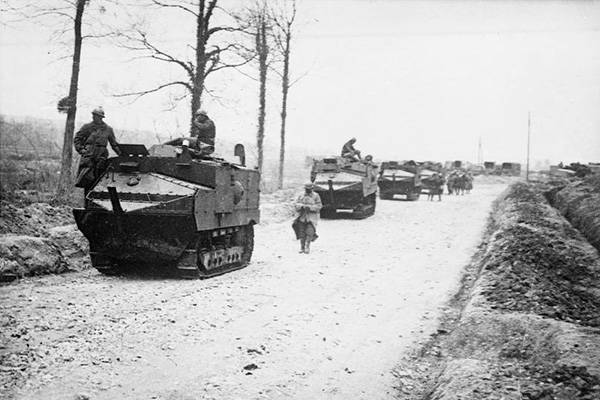
Tanks "Schneider", following the front to attack in the area of Reims. April 1917
Results
Allied attacks proved to be unsuccessful, the German front was not broken. Under pressure from the government, the operation was discontinued. Everything turned into another senseless slaughter and this operation went down in history as the “Nivel Meat Grinder”. In Nivel’s Slaughterhouse, the French lost 180 thousand people killed and wounded, the British 160 thousand people, and the Russians more than 5 thousand people (out of 20 thousand). The losses of the German army amounted to 163 thousand people (29 thousand prisoners).
After this unsuccessful 15 offensive in May, Nivelle was removed from his post, and General Henri Patin was appointed in his place - “the hero of Verdun.” A war minister was appointed Clemenceau, who was given dictatorial powers. In the French army, demoralized by the failure of the offensive (against the background of past "meat grinders"), insurrections began, soldiers refused to obey, leave the trenches, seize trucks and trains to go to Paris. The insurgency swept the 54 division, 20 thousand soldiers deserted. A wave of strikes took place in French military factories, in light industry and at construction sites. The workers of the metallurgical industry went on strike in May and June. However, the French authorities were not almond. The new commander is very hard to suppress all the performances in the army. Rallies and demonstrations dispersed lead. All publications that showed the slightest disloyalty dispersed. All prominent oppositionists were arrested. The rebel regiments were blocked by cavalry and disarmed. Some were shot on the spot, earned martial law courts. The tribunals condemned thousands of people, some were shot, others were thrown into prisons and hard labor. In July, an order was issued to impose the death penalty for refusing to obey. Thus, the French quickly restored order in the army and in the rear.
The revolutionary movement spread to the Russian Expeditionary Corps, which bravely fought and suffered heavy losses. The 1-I Special Brigade took Fort Brimont, repulsed several enemy counterattacks. The 3-I Special Brigade pulled ahead of the French, attacked the Pigs-Head redoubts, withstood a German counter-strike. French newspapers were delighted and extolled the "prowess of the troops of free Russia ...". The failure of the offensive and the huge sacrifices provoked outrage among the Russian soldiers. Knowing about the revolution in Russia, they demanded a return to their homeland. In July, the Russian units were removed from the front and transferred to the camp of La-Curtin, the camp was surrounded by French troops, who with particular cruelty suppressed the uprising of Russian soldiers by September 19. The 110 man was tried, the rest were sent to the Thessaloniki front.
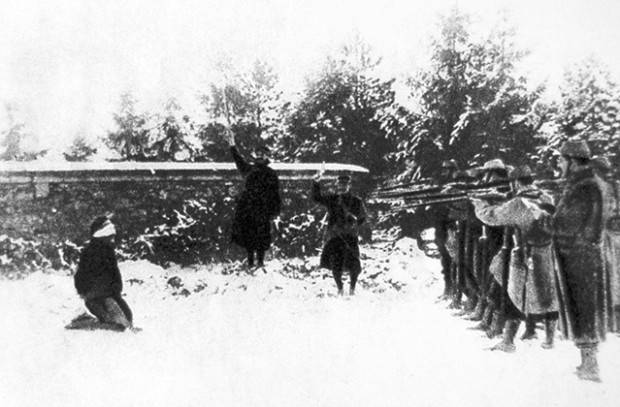
Execution near Verdun during riots in the French army
- Alexander Samsonov
- 1917 Campaign
The transition of the Central Powers to a strategic defense
Entente plans for 1917 year: bet on a decisive victory in the war
Russian army to the beginning of the 1917 campaign of the year: the approach of the general collapse
Attack without shot: Mitav operation
How Germany began the unlimited submarine war
German submarine vs UK
How the German submarine fleet tried to crush the "mistress of the seas"
The United States used the myth of "inhuman" submarine warfare to oppose Germany
Caucasian front in 1917 year. Baratov corps offensive in southwestern Persia
Mosul operation. How the British, until recently, tried to use the Russian "cannon fodder"
The war of the USA and England against Europe and Russia for absolute power on the planet
USA and World War I
How did the USA profit from World War I
"War will end wars." USA in the First World War
World War I turned the United States into a leading world power
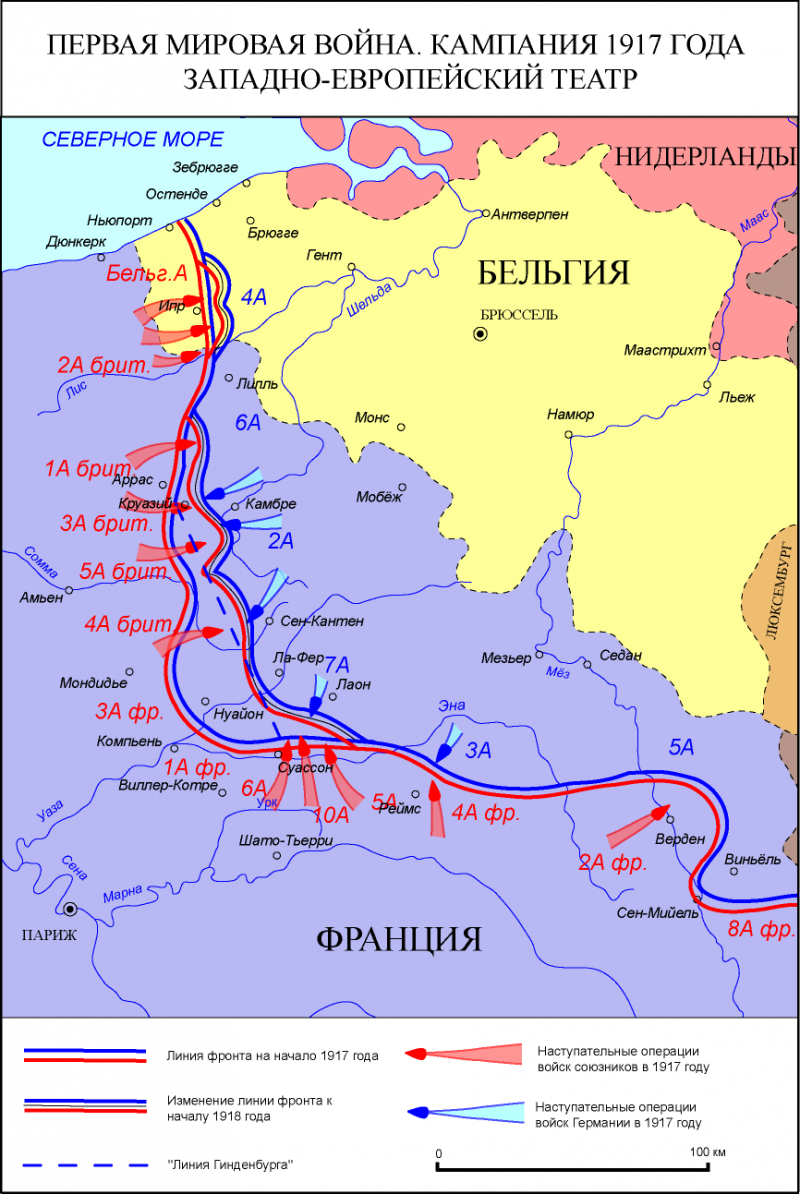
Information